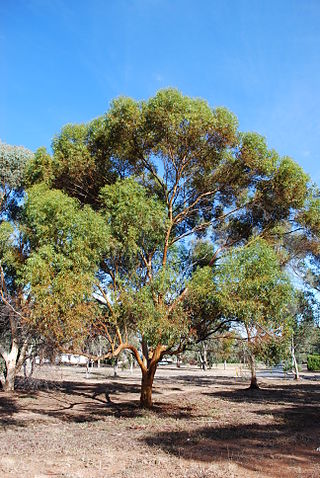
Eucalyptus salubris, commonly known as gimlet, fluted gum tree, gimlet gum and silver-topped gimlet, is a species of mallet that is endemic to low-rainfall areas of the wheatbelt and goldfields regions of Western Australia.

Eucalyptus campaspe, commonly known as silver gimlet or the silver-topped gimlet, is a species of tree that is endemic to Western Australia. It has smooth, shiny bark, lance-shaped adult leaves, flower buds in groups of seven, white flowers and cup-shaped or conical fruit.

Eucalyptus effusa, commonly known as rough-barked gimlet, is a species of mallee or small tree that is endemic to Western Australia. It has thin, rough bark on the base of the trunk, smooth bark above, linear to narrow lance-shaped adult leaves, flower buds arranged in groups of seven, white flowers and cup-shaped to conical fruit.

Eucalyptus falcata, commonly known as silver mallet or toolyumuck, is a species of mallee or marlock that is endemic to Western Australia. It has smooth bark, lance-shaped to curved adult leaves, flower buds in groups of eleven or thirteen, creamy white or yellowish green flowers and flattened spherical fruit.

Eucalyptus goniocarpa is a species of mallet that is endemic to southern Western Australia. It has smooth bark, glossy bluish adult leaves, flower buds in groups of three, creamy-white flowers, and ribbed, conical to barrel-shaped fruit.
Eucalyptus jimberlanica, commonly known as Norseman gimlet, is a species of mallet or a tree and is endemic to a small area in the Goldfields-Esperance region of Western Australia. It has smooth, brownish bark, lance-shaped adult leaves, flower buds in groups of seven and conical to cup-shaped fruit.

Eucalyptus ornata, commonly known as silver mallet, ornamental silver mallet or ornate mallet, is a species of mallet or tree that is endemic to Western Australia. It has smooth, grey bark, lance-shaped adult leaves, flower buds in groups of nine or eleven, creamy white flowers and broadly conical to hemispherical fruit.
Eucalyptus prolixa, commonly known as the square-fruited mallet, is a species of mallet that is endemic to the southwest of Western Australia. It has smooth bark, glossy green, lance-shaped adult leaves, flower buds in groups of seven, creamy white flowers and urn-shaped fruit that is square in cross-section.
Eucalyptus ravida is a species of small mallet that is endemic to Western Australia. It has smooth, shiny bark, lance-shaped adult leaves, flower buds in groups of seven, white flowers and conical to hemispherical fruit.
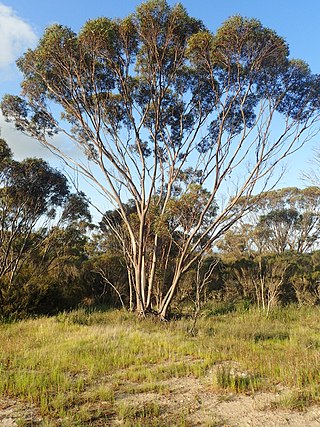
Eucalyptus scyphocalyx, commonly known as goblet mallee, is a species of mallee that is endemic to southern areas of Western Australia. It has smooth bark, lance-shaped adult leaves, flower buds in groups of three or seven, creamy white flowers and cup-shaped to cylindrical fruit.
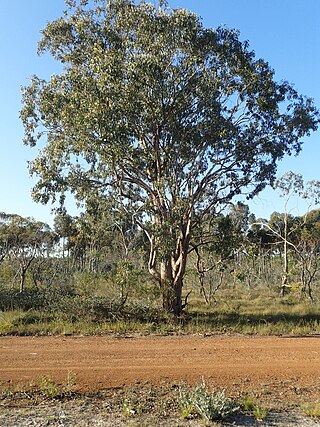
Eucalyptus sheathiana, commonly known as ribbon-barked gum or ribbon-barked mallee, is a species of tree or a mallee that is endemic to Western Australia. It has smooth bark that is shed in long ribbons, lance-shaped adult leaves, flower buds in groups of seven, creamy white flowers and conical to cup-shaped fruit.
Eucalyptus singularis, also known as ridge-top mallet, is a species of mallet that is endemic to Western Australia. It has smooth bark, sometimes with ribbons of rough bark at the base, lance-shaped adult leaves, flower buds usually in groups of seven, pale yellow flowers and cylindrical to barrel-shaped fruit.
Eucalyptus tenuis is a species of slender mallet that is endemic to the southwest of Western Australia. It has smooth bark, lance-shaped adult leaves, flower buds in groups of three, creamy white flowers and conical, cup-shaped or bell-shaped fruit.
Eucalyptus tortilis is a species of mallet and a gimlet that is endemic to the southwest of Western Australia. It has smooth bark, lance-shaped adult leaves, flower buds in groups of seven, creamy white flowers and hemispherical to cup-shaped fruit.
Eucalyptus urna, commonly known as merrit, is a species of mallet or marlock that is endemic to southern areas of Western Australia. It has smooth bark, lance-shaped adult leaves, flower buds in groups of seven to thirteen, creamy yellow to white flowers and urn-shaped fruit.
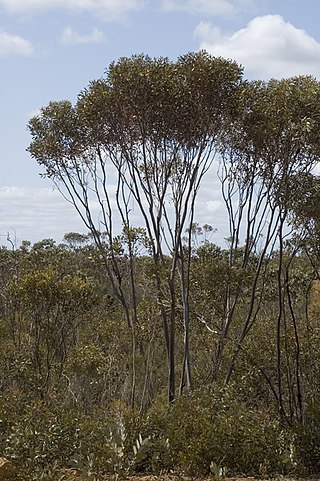
Eucalyptus captiosa is a species of mallee that is endemic to the south-west of Western Australia. It has smooth bark, lance-shaped adult leaves, groups of three or seven, slightly ribbed flower buds arranged in leaf axils, pale yellow flowers and cup shaped fruit.

Eucalyptus diptera, commonly known as the two-winged gimlet, is a mallet that is endemic to the south-west of Western Australia. It has smooth greenish to brownish bark, linear to lance-shaped adult leaves, flower buds in groups of three, each with two wings along the sides, creamy white to pale lemon-coloured flowers and cup-shaped to hemispherical fruit, also with two wings on the sides.

Eucalyptus extensa is a species of mallet that is endemic to Western Australia. It has smooth bark, lance-shaped adult leaves, flower buds in groups of seven, yellowish green flowers and hemispherical fruit with the valves extended well beyond the level of the rim.

Eucalyptus terebra, commonly known as Balladonia gimlet, is a species of gimlet that is endemic to Western Australia. It has satiny or glossy bark on its fluted trunk, linear to narrow lance-shaped adult leaves, flower buds in groups of seven, yellowish flowers and conical to hemispherical fruit. It is one of the seven species of gimlet.
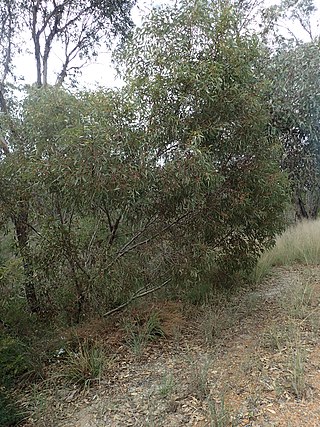
Eucalyptus × balanopelex is a mallee that is endemic to a small area of the south-west of Western Australia. It has smooth bark, broadly lance-shaped adult leaves, flower buds in groups of seven, creamy-white flowers and hemispherical fruit. It is thought to be a hybrid between E. kessellii subsp. eugnosta and E. semiglobosa.













